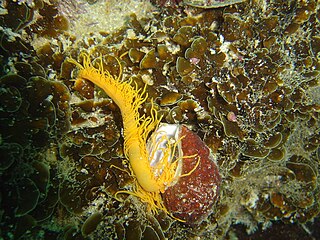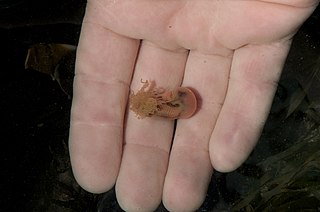
Nereis is a genus of polychaete worms in the family Nereididae. It comprises many species, most of which are marine. Nereis possess setae and parapodia for locomotion and gas exchange. They may have two types of setae, which are found on the parapodia. Acicular setae provide support. Locomotor setae are for crawling, and are the bristles that are visible on the exterior of the Polychaeta. They are cylindrical in shape, found not only in sandy areas, and they are adapted to burrow. They often cling to seagrass (posidonia) or other grass on rocks and sometimes gather in large groups.

Nereididae are a family of polychaete worms. It contains about 500 – mostly marine – species grouped into 42 genera. They may be commonly called ragworms or clam worms.

Terebellida make up an order of the Polychaeta class, commonly referred to as "bristle worms". Together with the Sabellida, the Spionida and some enigmatic families of unclear taxonomic relationship, they make up the subclass Canalipalpata, one of the three main clades of polychaetes. Like most polychaetes, almost all members of the Terebellida are marine organisms. Most are small, sessile detritivores which live in small tubes they build from mud or similar substrate, or burrow in the sand. Their central nervous system displays characteristic apomorphies.
Swima bombiviridis is a worm species that lives in the deep ocean. It is also known as the green bomber worm, green bomber worm, or bombardier worm. This deep ocean pelagic (free-swimming) annelid has modified bioluminescent gills that can be cast off from an individual. These discarded gills somewhat resemble green "bombs" that remain illuminated for several seconds after they have been discarded. It is thought that this is a defensive mechanism rather than reproductive, as it is seen in both mature and juvenile individuals. This species was the first of its genus, Swima, to be discovered, and was the only one with a formal scientific name as of 2010. The genus name, Swima, is derived from the Latin, referring to the animal's ability to swim. The species name, bombiviridis, is derived from the Latin prefix bombus, meaning humming or buzzing, and the suffix viridis, which is Latin for the color green. Swima bombiviridis therefore translates to "swimming green bomber".
Swima is a genus of marine polychaete worms found in the ocean at depths between 1,800 and 3,700 meters. Even if they are agile swimmers, they are often seen hanging immobile in the water column as they are neutrally buoyant. This deep ocean pelagic (free-swimming) genus has modified bioluminescent gills that can be cast off from an individual. These discarded gills somewhat resemble green "bombs" that remain illuminated for several seconds after they have been discarded. It is thought that this is a defensive mechanism rather than reproductive, as it is seen in both mature and juvenile individuals. And because they are eyeless, communicating with light would be difficult. Swima worms are closely related to the recently discovered genus Teuthidodrilus, another pelagic cirratuliform of the bathyal zone.

Phyllodoce is a genus of polychaete worms, which contains about 200 species. The prostomium bears eyes, two pairs of antennae and a pair of large retractile nuchal organs. The eversible proboscis is clearly divided into two parts.

Diopatra is a genus of polychaete worms in the family Onuphidae.

Amphinomidae, also known as the bristle worms or sea mice, are a family of marine polychaetes, many species of which bear chaetae mineralized with carbonate. The best-known amphinomids are the fireworms, which can cause great pain if their toxin-coated chaetae are touched or trodden on. Their relationship to other polychaete groups is somewhat poorly resolved.

Chrysopetalidae is a family of polychaete worms. The body is short or elongated, with few or numerous segments. All segments bear on their dorsal side a fan or a transverse row of paleae. The cephalic lobe has tentacles and eyes and the buccal segment has two or four tentacular cirri on each side. The parapodia are uniramous or biramous, with dorsal cirri upon all segments. The ventral bristles are compound.

Phyllodocidae is a family of polychaete worms. Worms in this family live on the seabed and may burrow under the sediment.

Eulalia is a genus of polychaete worms.

Karen Joyce Osborn is a marine scientist at the Smithsonian's National Museum of Natural History Invertebrate Zoology department. She is known for her work in marine biology specializing in mid-water invertebrates.

Poecilochaetus is a genus of marine worms within the Polychaeta. It is the only genus in the monotypic family Poecilochaetidae. Members of this genus are benthic worms that burrow into soft sediments.

Eunoe is a genus of marine annelids in the family Polynoidae. The genus includes 48 species which are found world-wide, mostly from depths of 50 m or more.

Scalibregmatidae is a family of polychaetes belonging to the order Opheliida, and was first described by Anders Johan Malmgren in 1867.

Thelepus is a genus of polychaetes belonging to the family Terebellidae.

Odontosyllis is a genus of annelids belonging to the family Syllidae.
Prionospio is a genus of annelids belonging to the family Spionidae.

Eumida is a genus of polychaetes belonging to the family Phyllodocidae.

Amphicteinae is a subfamily of polychaete worms in the family Ampharetidae. It was originally established as a tribe, with eight genera, but was elevated to subfamily-level with a reduced number of genera in 2020. Two species, Hypaniola kowatewskii and Hypania invalida, are known to feed on blue-green algae.

















